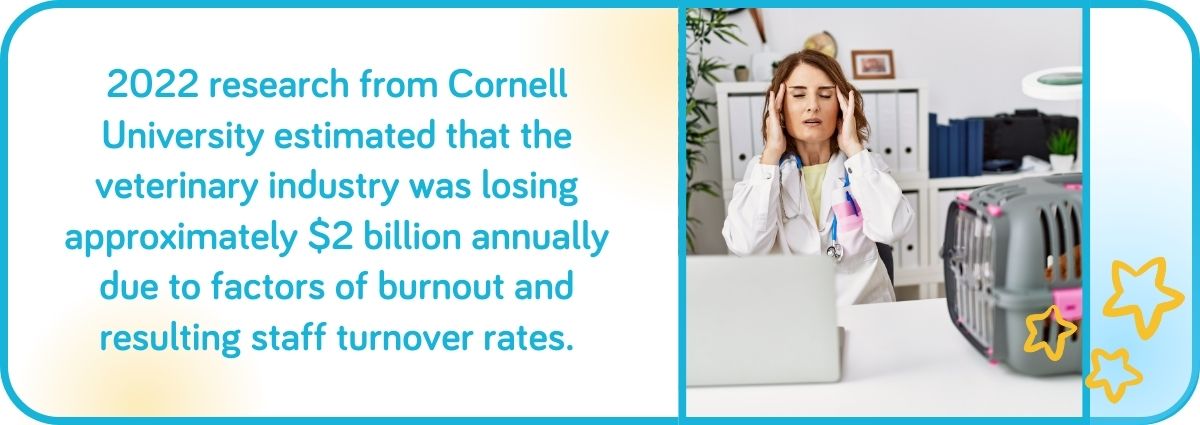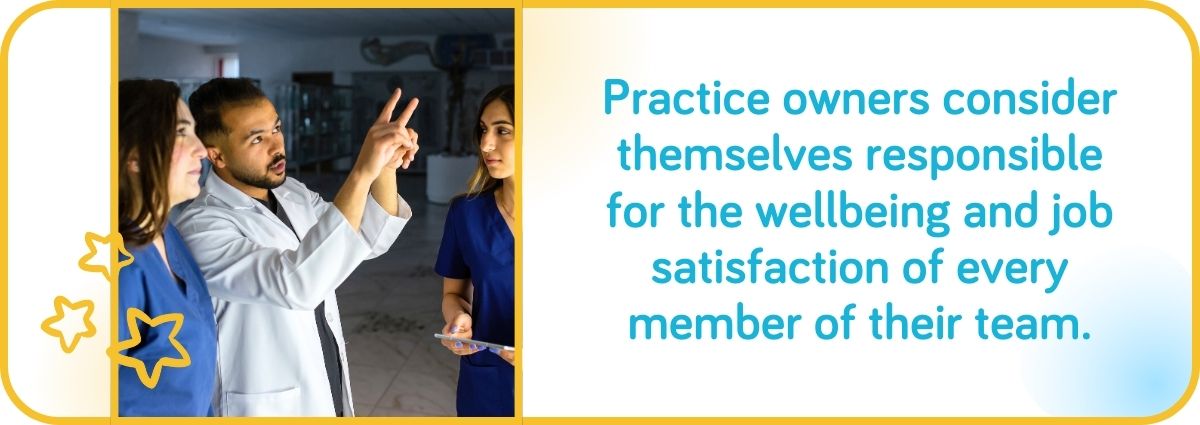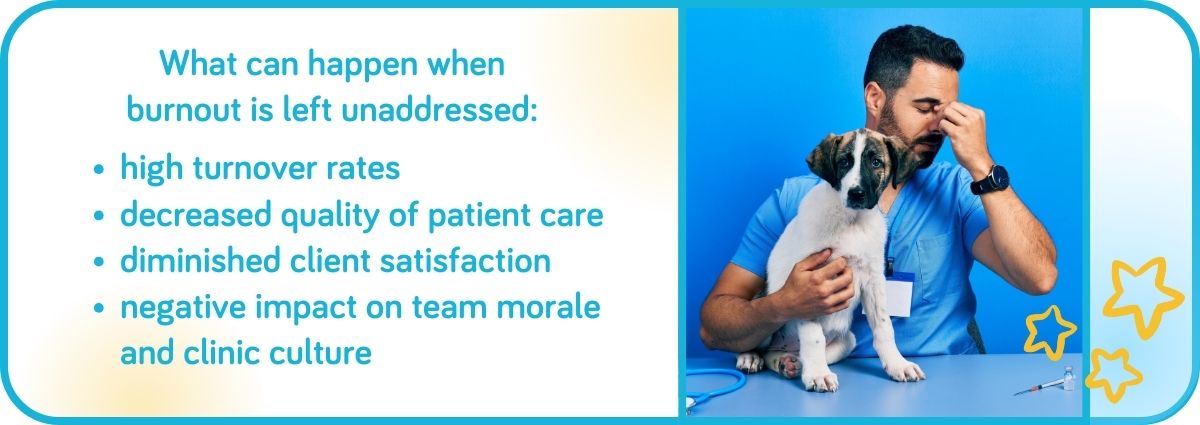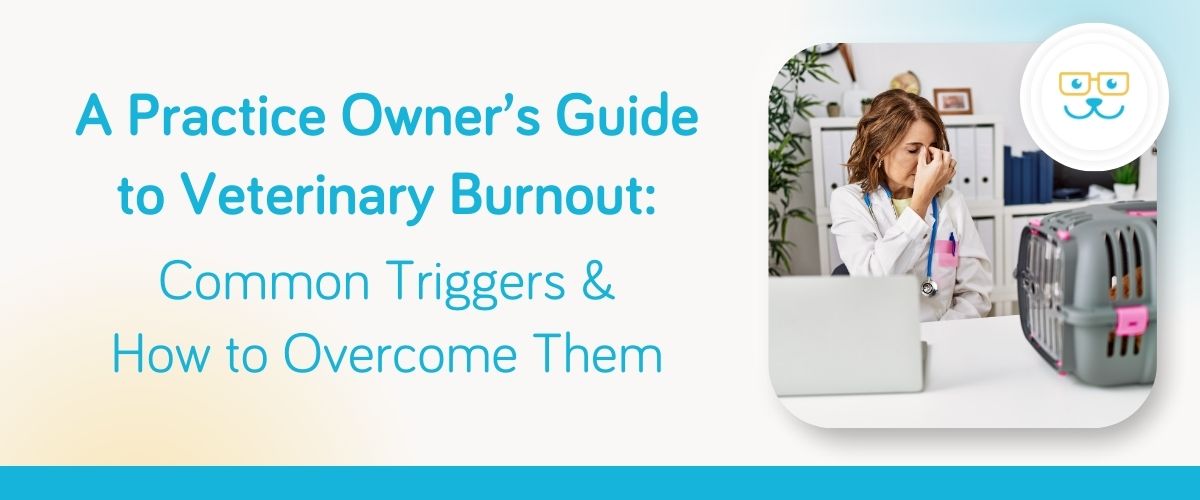A Practice Owner’s Guide to Veterinary Burnout: Common Triggers & How to Overcome Them
Running a veterinary practice is equally as rewarding as it is demanding. This dichotomy isn’t going to change. But here's the catch – it's this very mix of rewarding achievements and challenges that makes the veterinary profession unlike any other. Because of the ebbs and flows, burnout can easily creep into the lives of veterinary professionals, affecting not just the team's well-being but also the quality of care we offer. So what do we do?
In this blog, we'll explore the distinctive circumstances that contribute to burnout in veterinary medicine, identify common burnout triggers, share how you can recognize the signs of burnout in veterinary technicians and other staff members, and discuss effective strategies to combat and prevent burnout in your practice.

The Unique Circumstances of Burnout in Veterinary Medicine
Veterinary medicine is largely a passion-driven profession that revolves around providing exceptional animal care to pets or livestock and excellent customer service to animal owners. Many don’t get into the veterinary field for the glamor of the job or the pay, but, rather, choose to pursue careers in veterinary medicine because they are incredibly passionate about animals and want to contribute to advancing the science of animal care.
However, while many veterinarians, vet techs, and other clinic staff have likely rooted their career in this shared passion, they aren’t exempt from facing adversity in their roles. In fact, the very qualities that make our work so fulfilling can contribute to a serious problem that has increasingly affected the greater veterinary industry over the past decade: burnout.
The World Health Organization defines burnout as “a syndrome conceptualized as resulting from chronic workplace stress that has not been successfully managed. It is characterized by three dimensions:
- feelings of energy depletion or exhaustion;
- increased mental distance from one’s job, or feelings of negativism or cynicism related to one's job; and
- reduced professional efficacy.”
The emotional investment, long hours, and the challenging nature of dealing with sick or injured animals or their owners can take a toll on the mental and emotional well-being of veterinary professionals, ultimately leading to burnout. The effects of burnout can contribute to both personal and professional struggles that can impact your clinic’s operations and standards of care, as well as your staff’s, or even your own, work experience.
2022 research from Cornell University estimated that the veterinary industry was losing approximately $2 billion annually due to factors of burnout and resulting staff turnover rates. This devaluation within the industry demonstrates a greater need for veterinary leaders to better understand the unique causes and triggers of burnout, as well as contribute to the creation of systemic solutions that attack the root of the burnout phenomenon.
Common Burnout Causes and Triggers in the Veterinary Industry
Let’s be real; working at an animal hospital or veterinary clinic isn’t a walk in the park and it’s not all playing with puppies and kittens. Veterinary professionals regularly work long hours with demanding workloads, and their schedule can be even more jam packed in emergency situations or during busy seasonal periods. Veterinarians and vet techs are under constant pressure to meet high standards of care, while quickly and expertly handling dozens of diverse cases every day. Front office staff and other team members are typically always in “customer service mode” and spend hours working with clients and ensuring the rest of the practice runs smoothly by coordinating appointments, managing check-ins, taking payments, routing emergency calls, and more. With so many responsibilities and tight timelines, it’s not surprising that the veterinary industry has joined the ranks of professions experiencing higher than average rates of burnout.
Some of the leading causes of burnout within the veterinary industry include:
- Long Working Hours and Busy Schedules
- Emotional Fatigue
- Lack of Work-Life Balance
- Inadequate Resources or Support
- Lack of Recognition
- Difficult Cases or Undesired Patient Outcomes
- Feelings of Lack of Control or Voice on the Team
- Lack of Community or Team Environment
- Values or Skills that Don’t Align with Job or Practice Goals

While we often look at veterinary practice owners as strong, capable leaders who can weather any storm, it’s important to remember that they are certainly not exempt from burnout – and are, perhaps, at more risk than other veterinary professionals due to the added stressors of being a business owner. In addition to triggers we’ve discussed, being a veterinarian and business owner creates a unique cross section where additional burnout triggers are prevalent. Most notably, the financial aspects of running a veterinary practice can be a major source of stress for practice owners. Balancing the need to provide quality care with the financial constraints of clients can create tension and frustration and force practice owners to make difficult business decisions for the wellbeing of their clinic and the community they serve. Practice owners consider themselves responsible for the wellbeing and job satisfaction of every member of their team, and leading and supporting so many professionals, while often serving a full schedule of patients can be incredibly difficult and mentally and physically taxing.
Signs of Burnout in Veterinary Technicians & Staff
Being attuned to the signs of burnout is essential for early intervention. While burnout can manifest differently in different people, there are a few common signs that your staff may be experiencing burnout and may need additional flexibility, attention, or support. Look out for these indicators in your veterinary technicians and staff:
- Decreased Job Satisfaction: A sudden decline in enthusiasm for the job or a lack of interest in tasks that were once enjoyable could be an early indication of burnout. If your vet tech who typically fawns over your patients from puppies to elderly cats, but has recently become distant and has limited their interactions with animals in the exam room and seems to just be going through the motions, they could be experiencing burnout.
- Increased Absenteeism: Burnout can manifest in numerous mental and physical symptoms. If you notice an uptick in unplanned absences or requests for time off, it may be a sign that your team members are struggling with burnout. This can range from anything to requesting to leave shifts early or calling out for frequent sick or mental health days.
- Reduced Productivity or Presenteeism: Because burnout can be coupled with mental and physical exhaustion, it can lead to a decline in performance and productivity in all staff members, no matter their role in your clinic. If you observe a drop in the quality of work or a noticeable decrease in efficiency, it's time to address the issue. This can also be noted through presenteeism, where employees may be physically present at work but not engaging in the work or activities they need to be.
- Changes in Attitude or Customer and Coworker Interaction: Burnout can often manifest as mood irritability or a generally negative attitude toward their work or other topics. In the veterinary industry, these changes in mood or attitude can be most notable in the ways in which team members interact with each other as well as customers. If the sweet, shy receptionist has suddenly become curt over the phone with pet owners or has started to lose their temper when working with the rest of the team, burnout may be at the root of the issue.
How to Combat Veterinary Burnout in Your Own Practice
While every member of your team is unique and has different preferences, goals, and needs, all employees, no matter their role, share a few same fundamental needs within the workplace that veterinary leadership teams need to ensure are met to avoid burnout and contribute to a healthy, positive working environment.
Align Your Leadership Team
Every positive change within a veterinary practice starts with the leadership team. Creating an environment that combats burnout and a culture of overworking is the direct responsibility of the leadership team, meaning that if your team isn’t aligned and working toward the same goals, you can’t hope to be effectively implementing changes and policies that contribute to a healthy work environment.
Ideally, your leadership team should lead by example and take care of their own mental and physical wellbeing and enforce personal boundaries within the workplace. When your leadership is well rested, engaged, and invested in your practice, they can do a better job of taking care of the rest of your team. Remember, all good things start at the top.
Give Your Team Members Personal Attention
While we love thinking of our staff as one cohesive team unit, we still have to remember that in the end they are all individuals that have individual, personal needs. Within these needs, personalized attention can often be swept to the wayside due to the effort and consciousness needed on behalf of practice owners and other leadership figures. However, personal attention can help employees feel more noticed, appreciated, and fulfilled.
A little celebration and extra attention to personal victories or recognition of a job well done can go a long way in the veterinary industry. If you have a staff member who is going above and beyond, share your appreciation of them in a staff meeting or reward them with a special event or gift.
However, personal attention doesn’t always necessarily mean praise or celebration. A crucial aspect of personal attention that some veterinarians or managers may struggle with is finding the time to connect and check in with their teams on an individual basis. Scheduling regular 1:1 meetings is a great way to demonstrate to your employees that you’re committed to listening to and supporting them, and will allow you to connect with all of your employees on a more personal level.
Promote Work-Life Balance
Veterinary medicine can truly be a taxing career, and proper rest and self care are necessary to ensure your entire team is functioning to their full potential. Promoting a healthy work-life balance and understanding the physical and mental limitations of your team is crucial to curating a burnout-free environment. Encourage your team to take breaks, use their vacation days, and prioritize their well-being outside of work. Promoting a healthy work-life balance can prevent burnout and contribute to long-term job satisfaction, leading to happier patients, more satisfied employees, and a thriving practice culture.
Make Sure Your Staff Is Properly Supported
A little support can go a long way in helping your team feel able to accomplish their work-related goals and contribute positively to your practice. Ensure that your practice is well-equipped with the necessary resources that your team will need to not only complete their day-to-day tasks, but also thrive in their roles, including up-to-date technology, adequate staffing levels, and ongoing training opportunities. Investing in your team's success fosters a sense of support and appreciation that won’t go unnoticed.
Foster a Positive Culture and Healthy Work Environment
Fostering a positive and inclusive work culture is perhaps one of the most impactful things you can do for your practice and your employees. Dr. Michele Drake says, “When you have a well-defined culture, every employee knows what to expect when they come to work. They see everyone is aligned as a team, that there is cohesiveness among the leadership that flows down to all levels of employees.” To achieve this type of culture, encourage open communication, celebrate achievements, and address concerns promptly. A supportive environment where team members feel heard and valued can significantly reduce burnout.
Creating a healthy and engaging culture should also include empowering and involving your team in multiple aspects of the practice. Give your team members a sense of control and involvement in decision-making processes and let them know that their insights and opinions are valued and seriously taken into consideration when decisions are being made. When individuals feel their opinions are valued, they are more likely to be invested in the success of the practice and will be better contributors to your practice’s outstanding culture.
Communicate, Communicate, and Communicate More
We all know that communication is important. But, despite knowing its importance, most of us are still likely guilty of communicating too little. By focusing extra energy and effort toward communication efforts, you can drive a more positive employee experience, create community amongst your team, clarify practice mission and purpose, and, most importantly, make your team feel valued and heard.

What Can Happen When Burnout Is Left Unaddressed
When you or your veterinary staff are burnout, feel unfulfilled, or are just plain exhausted, their work, and, ultimately, your practice, is bound to suffer and feel the negative impacts.
Some of the most common ill effects of having burnout employees at your practice include:
- High Turnover Rates: In February of 2023, AAHA reported that turnover for veterinarians and veterinary technicians was hovering at about 25% – meaning, at any given time one in four veterinary professionals were leaving or starting a role. Burnout can prompt veterinary professionals to leave their clinic or role and seek a new veterinary environment, or leave the field altogether. High turnover rates are undesirable in any industry, but in the veterinary world, they can negatively impact the continuity of care and the overall success of a practice.
- Decreased Quality of Patient Care: As a veterinary worker, you understand that if your heart isn’t in your work, your craft will suffer. Burnout works hand in hand with this idea. Burnout can compromise the quality of care provided to animals, as fatigued and disengaged team members are more likely to make errors or do the bare minimum, leading to potential harm to patients and damage to your practice's reputation.
- Diminished Client Satisfaction: As we discussed earlier in the signs of burnout, burnout can manifest in mood and attitude changes, meaning decreased empathy and communication skills resulting from burnout can negatively impact client interactions and the standard of service your team is able to offer. Unsatisfied clients may seek veterinary care elsewhere, costing you valuable clients and ultimately affecting the financial stability of your practice.
- Negative Impact on Team Morale and Clinic Culture: The presence of burnout isn’t only experienced on a personal level for individual employees. When burnout is present in your practice, the triggers and resulting symptoms can create a ripple effect, causing far reaching negative impacts on multiple areas of your practice. One of the most notable aspects of your practice that can be affected is the culture and work environment. Burnout can shift your practice's culture and create a toxic work environment, affecting the morale and cohesion of your team. A dispirited and disconnected team is less likely to collaborate effectively, hindering the overall success of your practice.
Creating a burnout free environment is no easy task and will take a lot of intentional focus and effort from practice owners and clinic leaders. Remember, addressing burnout isn't just about preserving your practice — it's about caring for the individuals who dedicate their lives to caring for animals and ensuring a healthy and safe work environment for all veterinary professionals.
Ready to start on the path to a healthier practice? Let the GeniusVets team take a few things off your plate so your team can focus their time and energy on where they can make the biggest difference: exceptional animal care. Book a demo today.

